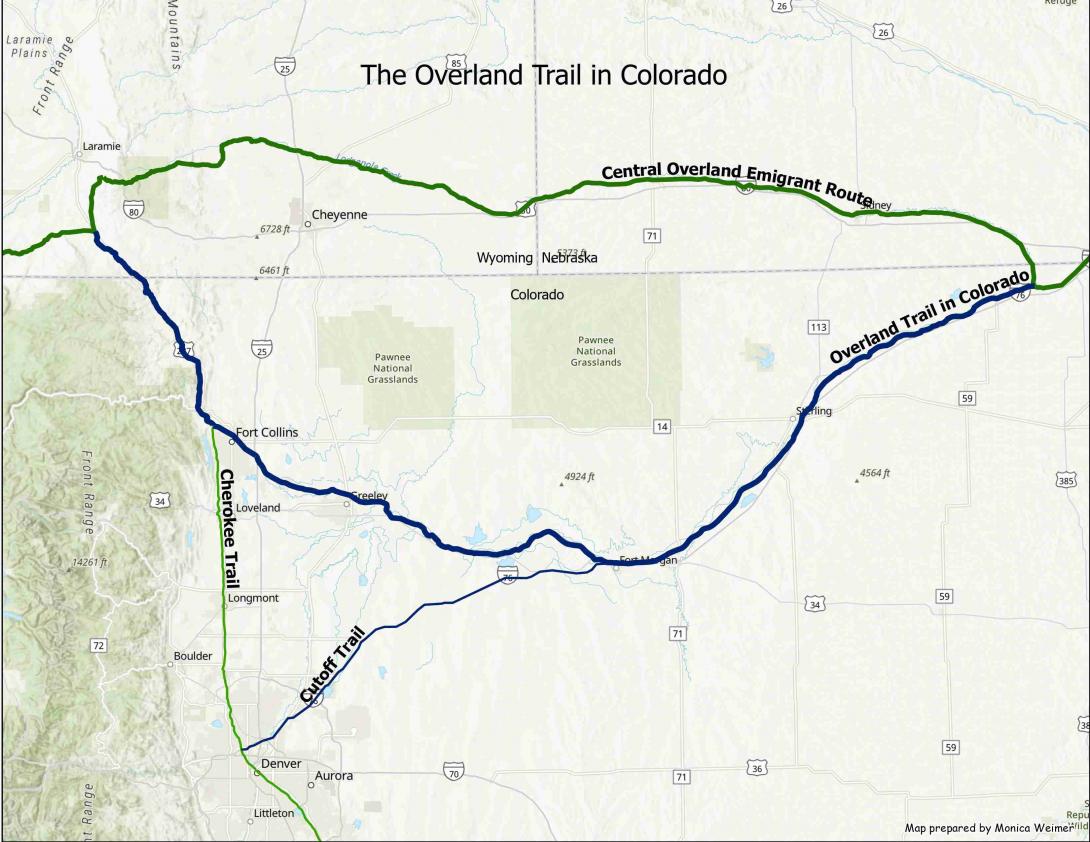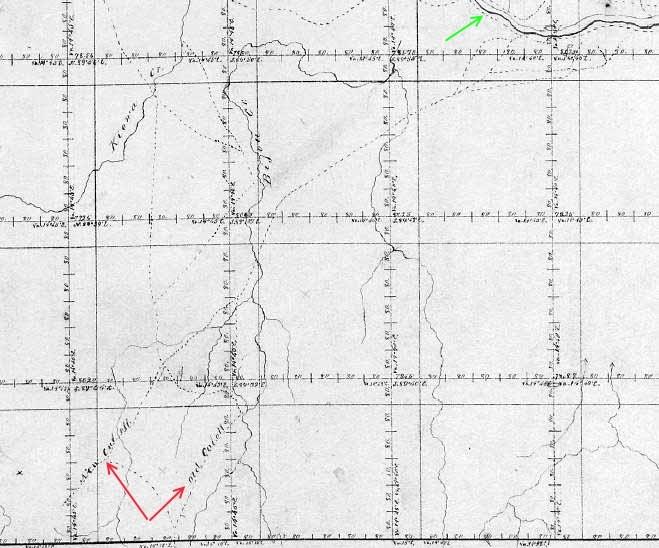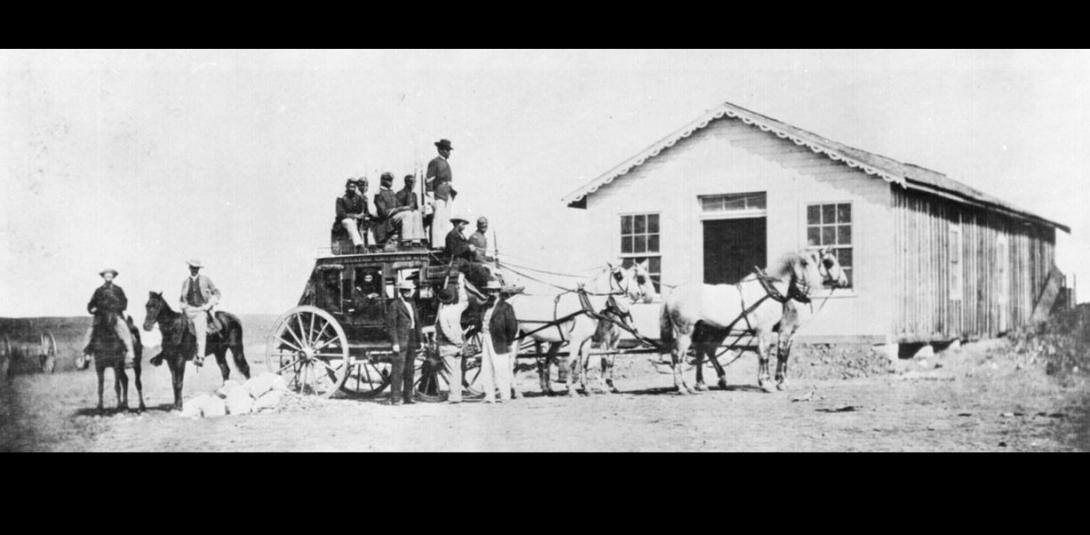Overland Trail
Full Article
The Overland Trail, also known as the "Central Overland Emigrant Route," was an important nineteenth-century corridor for explorers, colonists, miners, and traders that ran from Atchison, Kansas, to Fort Bridger, Wyoming. It followed preexisting Indigenous and early explorer trails throughout most of its length. At Julesburg, the Overland Trail in Colorado veered southwest from the main route, passing through Sterling, Fort Morgan, Denver, and Fort Collins before rejoining the main trail south of Laramie, Wyoming. The Overland Trail was later an important mail delivery route operated by the Overland Mail & Express Company, and Wells, Fargo & Co.
Origins
The Overland Trail in the northeastern part of Colorado followed the route established by Stephen H. Long (1819), which was then used by John C. Frémont in 1842 and 1843. In 1856, after Lt. Francis T. Bryan announced that he had discovered a “good Indian trail along the south side of the South Platte,” the US Army began using the route. In 1858 the army undertook many improvements, making it better suited as a stagecoach route, and the Overland Trail in Colorado was established. Two stagecoach companies had operated along the Overland Trail prior to 1862, but quickly went bankrupt.
In addition to spreading disease, the massive number of travelers on the trail reduced grazing lands and diminished important sources of game and shelter for Indigenous people. By 1862 Indigenous resistance along the Oregon Trail's main route prompted the US mail to move south to the Overland Trail. That same year, Ben Holladay, an entrepreneur known as the “Stagecoach King,” saw opportunity and bought the second of the failing stagecoach companies. Holladay supplied his newly formed Overland Mail & Express Company with sturdy Concord coaches and numerous new stage stations; a telegraph line was installed along the trail in 1863.
By early 1864, the Civil War required Union troops guarding the Overland Trail to turn their attention elsewhere. In late summer 1864, Lakota, Cheyenne, and Arapaho warriors attacked white stage stops and ranches on the Plains, attempting to drive the invaders from their homelands. With the increasing conflict along the trail and not enough troops to spare, the government closed the Overland Trail, resulting in serious repercussions for the residents of Colorado: mail delivery was slowed to a crawl, and food was in short supply.
Massacre & Mayhem
With their people starving or dying of disease, the bison herds disappearing, and white immigrants pouring across their lands, Indigenous nations needed no further reason to resist the US invasion. But in late November 1864, additional motivation came via atrocity. As the citizens of fledgling Denver reacted to the attack on the Hungate family beyond the city and feared a larger Indigenous attack, Colonel John M. Chivington, the military commander of Colorado Territory, ordered his troops to massacre more than 200 peaceful Cheyenne and Arapaho—mostly women, elders, and children—along Sand Creek on November 29. Chivington ordered the attack despite the two nations having submitted to US military protection and flying an American flag above their camp.
Knowing that Indigenous retaliation was coming, Chivington on December 2 ordered that traffic along the Overland Trail move to the “Cut-off Route.” This route turned southwest at Fort Morgan toward Denver, where it joined the Cherokee Trail and passed through Fort Collins, forcing the Holladay Overland Mail & Express Company to either move or abandon its entire infrastructure. Benjamin Holladay later testified to a congressional committee that the process of “removing barns, houses, stations, corrals, stock, provisions and other property” put him to “great cost and expense,” for which he felt he ought to be compensated by the government, despite previously receiving millions of dollars in subsidies for carrying the mail.
Decline
The year 1865 was a very violent one along the Overland Trail in Colorado. Nearly all the ranches along the route were burned, and Julesburg was essentially destroyed. Despite the continuing hostilities, in 1866 Wells Fargo bought the Overland Mail & Express Company from Ben Holladay for $1.8 million.
The advancing railroads overwhelmed the stagecoach travel industry within a few years. The Union Pacific Railroad arrived in a rebuilt Julesburg in 1867, and in 1869 the Battle of Summit Springs marked the last of the major military conflicts with Indigenous people on Colorado's Great Plains. Despite improved safety for travelers along the Overland Trail, the US government entered into a mail delivery contract with the railroad, effectively eliminating the majority of operating capital for the stagecoach companies. In 1870 the last stagecoach on the Overland Trail reached Denver, along with the first train.
Archaeology
Relatively little remains of the original trail, but archaeologists continue to pursue identification of trail remnants using archival research and remote-sensing techniques, such as aerial images. The Bureau of Land Management, for example, has curated and digitized original survey maps that depict the trail, drawn as early as 1867. Maps created by early explorers are also available online. Agriculture, modern roads (many of which were built atop the historic trails) and construction have erased almost all evidence of this historic corridor. However, field verification occasionally results in the identification of intact segments, and despite the near total destruction of buildings along the trail, several stage station sites have been recorded, and the Virginia Dale Stage Station still stands.
Life on the Trail
The interested reader can find many stories and detailed descriptions of the rough living that characterized travel along the trail. The most famous author who wrote about the Overland Trail was Mark Twain, in his book Roughing It. Accounts written by Edwin James and John C. Frémont, along with Benjamin Holladay’s congressional testimony, contain fascinating details that provide a sense of the trail culture during the 1860s.







